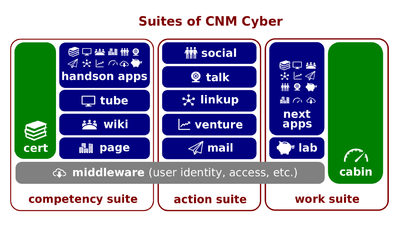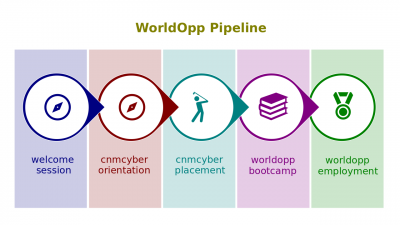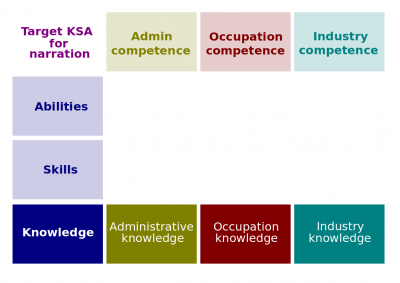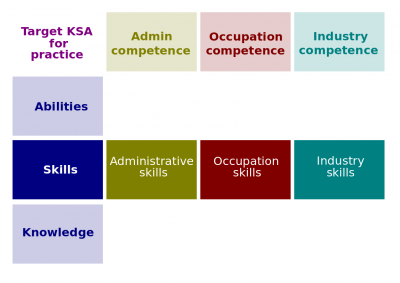Educational Methods
The Educational Methods (hereinafter, the Lesson) is the lesson of CNM Cyber that introduces its participants to CNM Cyber Orientation. The Lesson belongs to the Introduction to Education session of the CNM Cyber Orientation.
The Lesson is made up of three lectios. At CNM Cyber, the word, lectio, is used for a lesson part.
Contents
Summaries
Predecessor
- The predecessor lesson is Education Essentials.
Outline
Educational Methods Lectios # Referred topics Methods of Study 1 Learning Contents 2 Practical Instructions 3 Cognitive Studies 4 Experiential Studies 5
Successor
- The successor lesson is Learning Environments.
See also
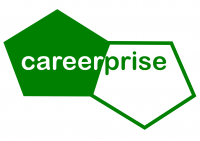
Educational Methods is the second lectio (or lesson part) in the Introduction to Education lesson. The lesson itself is the fifth in CNM Cyber Orientation. Consequently, the Orientation is the first stage of WorldOpp Pipeline.
This wikipage presents its full script and those test questions that are related to that lectio.
Educational Methods
- Main wikipage: Educational Methods; video (8:23)
- Educational method. An established procedure for one's education. These procedures are usually based on observation and direct experience. They can be grouped in several categories: narrated instruction, practical instruction, cognitive research, experiential learning, or any combination of those.
- Learning activity. Something that a learner does or is offered to do for his or her learning.
- Learning sequence. Any sequence of learning activities or educational objectives that any human-learning theory or one's intuition suggests.
- Learning content delivery. Any educational method such as narrated instruction or demonstrating that is based on direct delivery of learning content.
- Demonstrating. Any learning content delivery, in which learning content is delivered through one or more demonstrations.
- Job shadowing. Any combination of (a) demonstrating of one's routine behavior in the workplace, (b) first-hand explanation of that behavior, and (c) answering questions related to that demonstration that aims to provide the learner or learners with sufficient insight of the work.
- Narrated instruction. Any educational method that is based on some narration such as lecturing and storytelling.
- Lecturing. Any narrated instruction that is based on one or more lectures.
- Storytelling. Any narrated instruction that is based on telling stories related to the subject of learning.
- Practical instruction. Any educational method that is based on prescribed practical exercises related to the subject of learning.
- Hands-on training. Any practical instruction that is based on completion hands-on assignments according to step-by-step instructions.
- Guided experiment. Any practical instruction that is based on executing some experiments according to step-by-step instructions.
- Cognitive research. Any educational method that is based on experience that requires cognitive analysis, synthesis, and/or evaluation of the subject of learning.
- Formative assessment. An educational method that is based on assessment that is formatted to provide detailed feedback afterwards, possibly during debriefing or a lessons learned session. Learners may also be encouraged to either complete specified assessment activities or obtain specified scores on them.
- Substantive discussion. An educational method that is based on one or more discussions on the matters that go beyond conventionally-formalized concepts, possibly followed by debriefing or a lessons learned session.
- Socratic method. An educational method that is based on critical thinking while answering challenging questions related to the subject of learning.
- Elicitation technique. An established procedure for gathering data from human beings. Elicitation techniques are used in anthropology, cognitive science, counseling, education, knowledge engineering, linguistics, management, philosophy, psychology, and other fields. A person who interacts with human subjects to elicit information from them is called an elicitor. The most common techniques include interviews, brainstorming, focus groups, artifact testing, observation, and questionnaire survey.
- Experiential learning (activity-based learning, learning by doing, learning through play). Any educational method that is based on both direct experience and cognitive reflection on that experience. Those methods may include a wide range of techniques from observations to experiments and heuristics, but the following consideration of what was observed and what can be learned is the key. That methodology may also be defined as learning through reflection on doing.
- Project-based learning (problem-based learning). An educational method that is based on experiential working on real-world projects related to the subject of learning.
- Exploratory research. An educational method that is based on completing one or more researches that relate to the subject of learning, but which procedure cannot be fully prescribed and which results cannot be completely estimated.
- Learning through failure. A heuristic to utilize experience for learning.
- Case-based learning. An educational method that is based on usage of decision-forcing cases to put students in the role of people who were faced with difficult decisions at some point in the past. In sharp contrast to many other educational methods, the case method requires that instructors refrain from providing their own opinions about the decisions in question. At the same time, instructor's feedback may be provided during the following debriefing or a lessons learned session.
Script
The video of the presentation is published at https://youtu.be/gjTMEDHpj3o (8:23). Here is its full text.
Overview
- Welcome to Educational Methods. In this brief presentation, we are going to take a look at those methods that educators use. Let's roll.
What an educational method is
- Educational method is an established procedure for one`s education. This procedure can be grouped in several categories; narrated instruction, practical instruction, cognitive research, experiential learning or some combination of those. Before jumping into these groups let`s site social learning theory which suggests that we can learn through both, observation and direct experience. Sometimes you just go, look, observe and you can learn from that. You don`t need a special setting or arrangement.
Narrated instruction
- Anyway, back to narrated instruction. This is any educational method that is based on narration such as lecturing, storytelling, demonstrating.
- Lecturing is based on lectures, storytelling is like telling stories and demonstrating includes one or more demonstrations. If you take a look at knowledge, skills and abilities which of these type of methods target, mostly target knowledge. It doesn`t give like a feeling or skills, or abilities, it`s not like beyond ability basically it`s knowledge. It gives administrative knowledge, occupation knowledge, industry knowledge if we talk about employment and KSA`s.
Practical instruction
- Let's go to practical instruction. Practical instruction is any educational method that is based on prescribed, practical exercises relate to the subject of learning. It can include hands on training or guiding experiment. You have a very strict instructions or guides or steps i.e. do this, click here, click there, see what happens and you learn from that hands on experience.
- Let's take a look at targets and knowledge, skills and abilities. For this type of educational methods. It targets primarily skills. Of course it can be combined with knowledge or maybe abilities further but mostly target skills. It`s supposed to give you some feeling, how to feel like, how you can be a coder, you have coded a line so you have this feeling of emotion. So it gives skills but at the same time skills without knowledge may not be useful. Usually practical instructions are combined with something else.
Cognitive research
- Moving to cognitive research, this is educational method that is based on experience that requires cognitive analysis and or evaluation of the subject of learning. They key word is cognitive. It`s only related to knowledge again. And here, we have cognitive assessment. Let’s say if you want to take exam based on this lecture you will be given a formative assessment and you will be given a feedback, you will be given your result based on your answers. In this case you can learn through your assessment substantive discussion debate on some critical issues and is not prescribed. Especially it`s useful when the debriefing follows. This method was developed in the Harvard School of Business and basically it`s goal is to put learners into real world situations given some knowledge and force them to make a decision. In this case, teachers cannot be a part of a decision making. Their role is to be observers and later facilitate debriefing for lessons.
- One more method is Socratic method, which was developed according to this letter by Socratis in ancient Greece and Socrates instead of giving answers on questions of his students, try to ask the questions and prompt them to arrive on their own conclusions. So to use critical thinking while answering challenging questions related to the subject of learning.
- Going back, cognitive research deals mostly with knowledge. It gives you like a better understanding or better feeling that it doesn't necessarily give skills and abilities, in some cases it is not direct, it cannot be a role that is why target KSA matrix but once again it`s not about experience.
Experiential learning
- Experiential learning, in other words learning by doing, or learning through play is any education method that is based on both direct experience in cognitive reflection on that experience. Cognitive reflection is the key because technically you can have some experience but that not necessarily lead you to learning. Some people live in the United States of America but they practice some English but they never learn English because they don`t reflect on that English and they can still be in their own language. So experiential learning can be project based learning, when you are given some project and work in a project sometimes in the team and project leads to some results, exploratory research where no one can know where their answer will be and I like learning through failure. In many cases it is how we learn faster than in any other methods.
- Once again getting back to experiential learning definition, this methodology may also be defined as learning through reflection on doing.
Summary
- This concludes the Educational Methods presentation. We have defined educational methods and taken a look at major of them such as narrated instruction, practical instruction, cognitive research, and experiential learning. One heuristic called learning through failure was given a special consideration. If you haven't done yet so, you are now welcome to move to Learning Environments.
Quiz questions
- Every statement below is split into one true and one false question in the actual exam.
- Self-education is (not) education that is facilitated only by acknowledged schools, colleges, and universities.
- Self-education is (not) education that is organized by a learner him- or her-self.
- Self-education can (not) be active.
- Observation is (not) an example of self-education.
- Observation is (not) an example of narrated education.
- Observation is (not) an example of practical instruction.
- Observation is (not) an example of active learning.
- Lecturing, storytelling, and demonstrating are (not) examples of self-education.
- Lecturing, storytelling, and demonstrating are (not) examples of narrated education.
- Lecturing, storytelling, and demonstrating are (not) examples of practical instruction.
- Lecturing, storytelling, and demonstrating are (not) examples of active learning.
- Hands-on training, directed research, and formative assessment are (not) examples of self-education.
- Hands-on training, directed research, and formative assessment are (not) examples of narrated education.
- Hands-on training, directed research, and formative assessment are (not) examples of practical instruction.
- Hands-on training, directed research, and formative assessment are (not) examples of active learning.
- Discussion, project-based learning, and exploratory research are (not) examples of self-education.
- Discussion, project-based learning, and exploratory research are (not) examples of narrated education.
- Discussion, project-based learning, and exploratory research are (not) examples of practical instruction.
- Discussion, project-based learning, and exploratory research are (not) examples of active learning.
- Discussion, project-based learning, and exploratory research can (not) be self-directed.
See also
- Learning Environments. The third presentation in Introduction to Education.
- Education Essentials. The first presentation in Introduction to Education.
